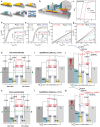Ternary Logic Transistors Using Multi-Stacked 2D Electron Gas Channels in Ultrathin Oxide Heterostructures
- PMID: 39680479
- PMCID: PMC11809351
- DOI: 10.1002/advs.202410519
Ternary Logic Transistors Using Multi-Stacked 2D Electron Gas Channels in Ultrathin Oxide Heterostructures
Abstract
2D electron gas field-effect transistors (2DEG-FETs), employing 2DEG formed at an interface of ultrathin (≈6 nm) Al2O3/ZnO heterostructure as the active channel, exhibit outstanding drive current (≈215 µA), subthreshold swing (≈132 mV dec-1), and field effect mobility (≈49.6 cm2 V-1 s-1) with a high on/off current ratio of ≈107. It is demonstrated that the Al2O3 upper layer in Al2O3/ZnO heterostructure acts as the source/drain resistance component during transistor operations, and the applied potential to the 2DEG channel is successfully modulated by Al2O3 thickness variations so that the threshold voltage (Vth) is effectively tuned. Remarkably, double-stacked 2DEG-FETs consisting of two Al2O3/ZnO heterostructured 2DEG channels with a single gate exhibit multiple Vth, enabling a ternary logic state in a single device. By inducing a voltage difference between the stacked channels, a sequential operation of the upper and lower FETs is achieved, successfully realizing a stable ternary logic operation.
Keywords: 2D electron gas; atomic layer deposition; multiple threshold voltage; multi‐stacked channel; ternary logic transistor.
© 2024 The Author(s). Advanced Science published by Wiley‐VCH GmbH.
Conflict of interest statement
The authors declare no conflict of interest.
Figures



References
-
- Zaitseva E., Levashenko V., Lukyanchuk I., Rabcan J., Kvassay M., Rusnak P., Electronics 2020, 9, 12.
-
- Heung A., Mouftah H. T., IEEE J. Solid‐State Circuits 1985, 20, 609.
-
- Yoeli M., Rosenfeld G., IEEE Transactions on Electronics Computer , IEEE; 1965, EC‐14, 19.
Grants and funding
LinkOut - more resources
Full Text Sources
Research Materials
